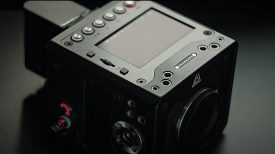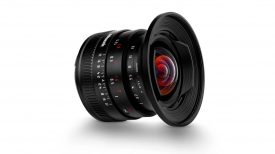By Dslrnewsshooter contributor Jonah Kessel:
HOPEFUL from Jonah Kessel on Vimeo.
For nine months, the words of picture editor at large Mike Davis have been haunting me. Last February on his blog, Davis wrote:
“Given a choice, I avoid multimedia like the plague. Why? Because most of it sucks. Even the name sucks.”
So, why should I care if a 15-year veteran former picture editor for National Geographic magazine hates multimedia? After his light-hearted introduction, Davis goes on to say:
“Why does most multimedia suck? It’s as if God wrote on stone tablets that all pieces called multimedia must follow a three-commandment formula: 1. Thou shalt approach subject matter that mostly happened in the past. 2. Thou shalt point a video/audio producing machine at a person looking at said machine and ask them questions, as the primary story telling medium. (You may separate said audio from said video with papal dispensation.) 3. Thou shalt make video of something in the present tense that may or may not have anything to do with that past event and then overlay that video cleverly with the interview audio to suggest a connection between the two, without being too misleading.
And this formula, for me, is almost always uninteresting, especially when compared to the potential of engagement and story telling dynamics when using all these media. The greatest, if not only, benefit of the three-commandment approach is that you can guarantee it’ll produce something you can put online and it will take a predictable amount of time to produce.”
Reading through Davis’ commandments I thought about the more than 60 videos or multimedia pieces I had made at that time and realized I had largely been a devoted follower of this clumsily named digital religion. Furthermore, in many ways, I agreed with him. And for the last year I’ve been thinking about the consequences of making multimedia productions with this formula and trying to find ways to avoid it.
Although I have lots of ideas on this, I don’t have a secret answer. But lately, I’ve been experimenting with form. And on a recent assignment in South China, I went much further when I had an open opportunity to experiment.
Friends of Nature, a Chinese environmental advocacy NGO, approached me, asking me to make a video about them and their movement to push for environmental legal reform in China. Trying to create something unique and powerful while maintaining the message of the NGO, I suggested we create something that was part real time video journalism, part documentary and part cinematic movie.
The first step was research. I had a research assistant write one page biographies of members of the NGO who could possibly be featured in the video. I knew it would be easier to connect the viewers to a person, rather than a law or topic they probably had no personal connection to. Character driven stories are good this way.
After I chose a person to feature, I began by interviewing them off camera as well as other members of the NGO about their goals, their plans and what they were actively involved in. I took this information and the bio and created a script that used real quotes from my interviews with NGO members, combined with facts and my own words to create an inner monologue of the main character. By doing this, it allowed me to knock out a narration and create a verbal flow to connect the images.
While the words are precisely written, I’ve tried not to augment the truth or misrepresent the situation or individuals involved. In some situations, their word-for-word quotes are integrated into my paragraphs to tell the story accurately while steering the movie in the right direction. To help add greater depth to the inner monologue, I shot a two question interview with the main subject. The idea was to create the subconscious feeling in the viewer that the inner monologue is a response to an unseen documentarian’s questions. The goal was to evoke a feeling of truth in the video because, after all, these are real people talking about a real problem.
During the meeting scene and two character interviews, no one was told what to say, although I asked questions and started conversations that I knew would produce dialogue which could be easily integrated into the previously written inner monologue driving the piece.
My main tool in trying to make this video visually interesting was to ensure something would happen in the present and avoid Davis’ first commandment. Some of the events in this video happened in the past (the actual dumping of chemicals) and some of the things are yet to happen (the actual law suit). By looking into the NGO’s schedule I was able to find a point where the main character would collect evidence. This would be the vehicle to keep the video at least partially in the present.
This part of the video would be more like a traditional video news report. We simply rented a car and I followed the character around as he investigated his case and talked with people. This part of the video, filmed in South China, was completely unscripted and shot just like any other documentary. While this part of the film was a run-and-gun effort, the section filmed in North China was completely set up based on research describing the character’s real life. He likes to play Go (Weiqi), he bikes to work, he works in a messy office, etc. The visuals in this part of the film were carefully scripted to create a cinematic opening to set up the main character’s trip to South China.
In the end, I have a mixed form video that I can’t quite define. After seeing the video, a friend and fellow filmmaker in Beijing said to me: “You’ve made a commercial.”
I thought about these words for a while. In Yunnan, I had been wandering the streets, trying to get people to talk to me. We hadn’t planned any of the shots. The interviews, meeting — also unscripted. However, there was a tremendous amount of planning and thought put into the piece. Before the two-day shoot began, I already knew in advance what would be happening for most of the film both visually and audio-wise. But does this make it a commercial?
The NGO had a goal: to increase public awareness and knowledge of the legal tools open to Chinese grassroot organizations and NGOs. Clearly, the video has a message and a point of view.
However, I still don’t believe this makes it a commercial. But I’m not quite sure it’s a documentary either. Because this video was privately funded, I had much more room to push the boundaries of ethics. Interjecting, or controlling the elements this much, would not be acceptable in the video journalism world. But should it be? If I were to interview the factory, some scientists and doctors I could create a much more well rounded picture with this story. In that situation, would this treatment be ethically acceptable, journalistically speaking?
Davis’ three commandments are not to be found here and I believe it creates a more interesting piece of multimedia. Beyond this, I believe there is an important lesson to take away from this example and our habits as visual journalists.
We should not let what others do suffocate our own creativity. Just because many people shoot anachronistic images and then “overlay that video cleverly with the interview audio to suggest a connection between the two, without being too misleading” doesn’t mean, we have to. At the same time, just because a veteran photo editor says “multimedia sucks” doesn’t mean that (a) it does and (b) we should stop innovating.
Have I created a truthful story? Is it an advertisement? Is it politically fuelled? In this case, the answer doesn’t matter. Following ethical guidelines is important, but the boundaries with our technology and medium are still yet to be discovered. We should all be pushing past Davis’ three commandments.

KIT LIST
This video was shot with:
Canon 5D mkIII
Canon 5D mkII
Contax/Carl Zeiss Distagon 28mm f2.8
Contax/Carl Zeiss Distagon 35 mm f2.8
Contax/Carl Zeiss Planar 50mm f1.4
Contax/Carl Zeiss Planar 85mm f1.4
Contax/Carl Zeiss Sonnar 135mm f2.8
Contax/Carl Zeiss Sonnar 180mm f2.8
Canon 100mm f2.8 Macro USM
Canon 70-200mm f2.8 L USM
Schneider Optics 77mm True-Match Vari-ND Filter
Sachtler Ace Tripod
Letus Direct Master Cinema Series Cage with Letus Follow Focus
Kessler Crane Pocket Dolly v2.0
Motion Research Blackbird Steady Cam
Rode NTG-2
Rode Stereo Video Mic Pro
Rode Video Mic
Sony UWP-V1 Wireless Lavalier Microphone
Zoom H4N
Zacuto EVF
Filmed using the Cinestyle Picture Profile, Sharpness: 0, Contrast: -4, Saturation: -2, Color Tone: 0, ISO: 160, Shutter set at 1/50th for entire film.
— Jonah M. Kessel is a freelance visual journalist working with the New York Times in China. See his site here, blog here or keep up with him on Twitter here.






